I have to say that prior to this review I had not heard of Glossika.
I was contacted by the company and asked if I'd be interested in reviewing the platform for my readers.
It looked pretty interesting, so I replied and let them know that I would need to fully test the platform myself and do a month's learning before writing a review.
They agreed, and gave me access to an account for a month. Below I detail my experience, no holds barred.
If you are thinking of investing in this learning platform to learn Thai, or any other language, I think you're going to find this very helpful.
So let's get started:
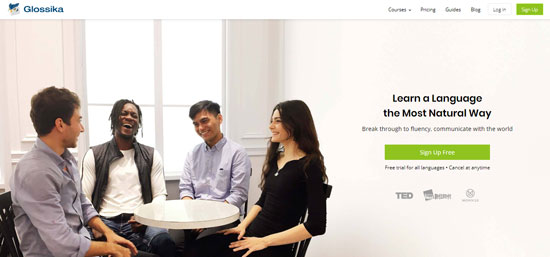
Glossika – In a Nutshell
Developed by an American linguist and phonologist, Michael Campbell, Glossika is an audio method based largely on repetition learning and the so-called “spaced repetition method”.
What was immediately noticeable to me was just how simple the overall approach is, and I have to say, this won't be for everyone.
Learning a language can be very trying, and for some learning has to be engaging on numerous levels for them to maintain interest and really advance.
I will tell you straight off the bat that if you are intending to learn Thai and you are a beginner, or even a lower intermediate learner, you should use Thaipod101.
You will not be able to get the full potential out of Glossika if you do not have an understanding of the Thai alphabet, because in many instances you are required to write the words in Thai.
Even though prior to having to write the word on your own you will be shown an example, if you don't know what the letters and vowels are, and the sounds they make, simply just copying them down will not help you learn them.
You will know what they look like, but not their sounds, and how they interact together.
In fact, by Glossika's own admission, the system is best used in conjunction with other learning tools and is not for beginners.
Personally, I feel that the system is designed for those with a good foundation in a language and want to really test themselves in their ability to understand, repeat and write down phrases that come up in everyday conversations.
Glossika is heavily focused around the repetition of real-life conversations, and where the Thai language is concerned I can vouch for the fact that I was presented with very useful and accurate phrasing. Bonus points there.
The system is very clever in that it tracks your learning and can adjust the speed that you learn at to keep pace with your ability.
So, in a nutshell: it uses a repetitive learning approach, is simple to use, and uses intelligence to adjust your learning algorithm.
Now let's dig deeper into the features of the system.
The Rep System
Just quickly, if you can't be doing with my waffle and want to give this a go right now, you can sign up for a seven day free trial, which I really recommend because you won't know if this is for you until you try it for an hour or so.
Glossika is what it is. There isn't a multitude of learning materials to choose from here; the system is designed by polyglots with the intention of fast learning and clocking up miles towards fluency as quickly as possible.
During your trial period, you’re given full access plus 1,000 reps in every language.
Rep, short for repetition, is the number of times you have practiced each sentence. It is used by Glossika to evaluate your learning progress.
If you turn on the recording feature, your data will be sent to the Glossika system, which will adjust your learning speed based on your accumulated reps.
Once logged in, click on Start My Training, and you’ll be presented with the available languages.
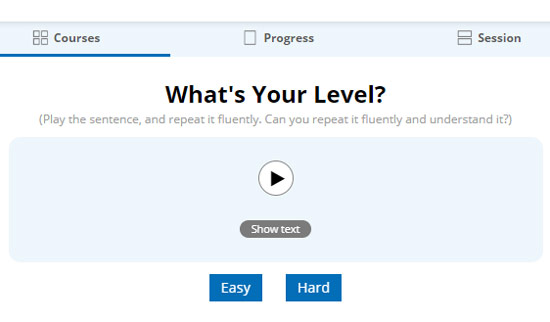
Personally, I selected English as my source language and Thai for the target language. Glossika then gauged my ability to understand, read, and speak Thai (click on the play button or show text to reveal the sentence).
I was able to repeat and understand the recording, so I click Easy.
Easy, right?
For Topic, be sure to select all topics for a wide variety of sentences. And that’s it! You have started your session.
Navigating the Settings
When you click on the Settings button, you’ll find the following features:
- Interval Between Sentences and Speed: This allows you to control the interval between every sentence and the speed they are presented.
- Recording: If this feature is on, it records the way you repeat the sentences, and the recording will be used to improve your algorithm.
- Level and Topics: it allows you to change your level (easy or hard) and topics.
- Daily reminder: I like this feature and really need it considering just how many things I have in my life that way saying I need to do more of, such as my music lessons a mountain of books I have to read.
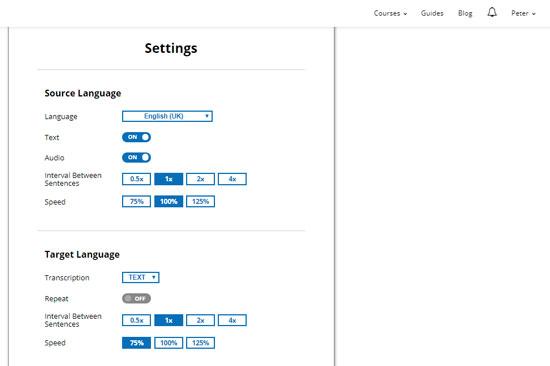
Lesson Format
The lessons are divided into five sections, as below:
1. Typing
As implied by the section’s name, Typing asks you to type into the box the same sentence that’s spoken or flashed on your screen. If you’re taking a course with a non-romanized alphabet such as Thai, you should be ready with the corresponding keyboard.
You can also choose the difficulty level of the sentences and the way they are shown; just click the Settings button and select your preference. You can do this in every other section too.
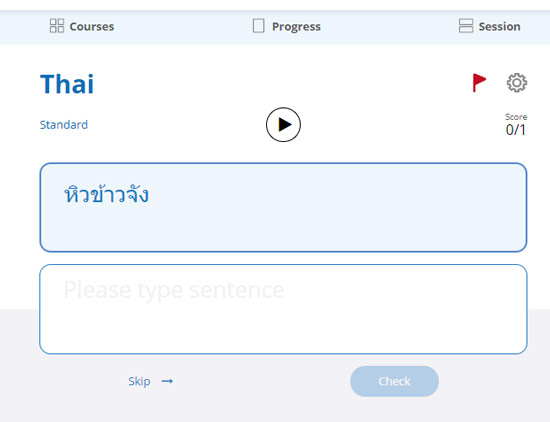
2. Dictation
Basically, Dictation is the no-show, audio-only version of Typing.
A box is provided where you’re expected to type the recorded sentence. Based on what I hear, I think the sentences used are the same in both sections.
As I said earlier, repetition is the name of the game, so if you’re the type who is easily bored, Glossika may not be your best bet.

3. Choice
Choice means multiple choice. You are presented with sentences in their International Phonetic Alphabet (IPA) version by default or romanized if you prefer. Four options are given, and you need to match the given sentence to the correct answer.
To survive Choice, you’re expected to know how to read the Thai alphabet. In this respect, you would need to be learning the alphabet separately via another channel.
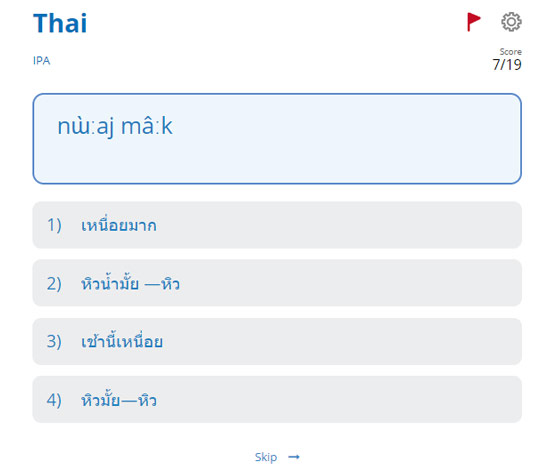
4. Translation
Translation — you get it; you literally translate the Thai sentence being spoken in the recording. You need to choose from the four options that are presented in English.
Click the Settings button, and you’ll see a drop-down menu that allows you to change your source language conveniently.
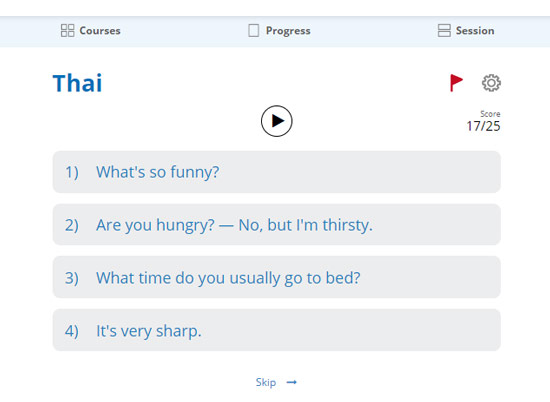
5. Fill In
Fill In is the same as Typing, only that not all words of the sentences are shown. In very short sentences though, the whole sentence may not be displayed, leaving you to fill in the correct answer and rely on the fundamentals you have already learned.
Just like the others, this section requires knowledge of the Thai alphabet.
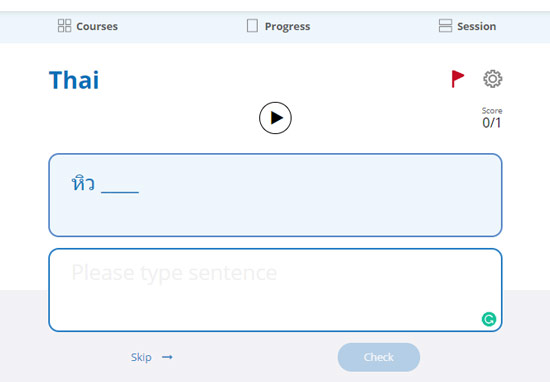
User Experience
As I’ve mentioned, the design is pretty straightforward and it is certainly easy-to-use. If you are someone who is not very tech-savvy and easily confused by lots of different menu options, you will find your way around Glossika in just a few minutes.
You can also find answers to almost all questions in their Help Center. The Blog, on the other hand, provides you with some pretty good language-related articles.
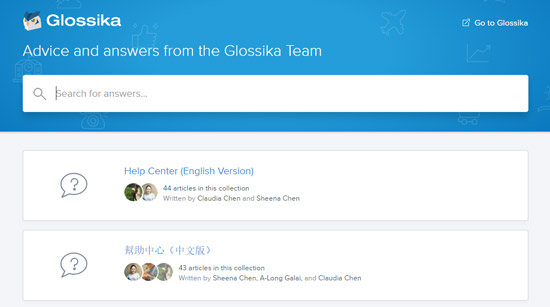
Glossika doesn’t yet have a mobile app yet.
In the meantime, if you don’t have access to your laptop and can rely only on your phone, you can log into your Glossika account via a your phone's browser. Everything works just like in desktop, except that you won’t be able to use the recording function when doing reps.
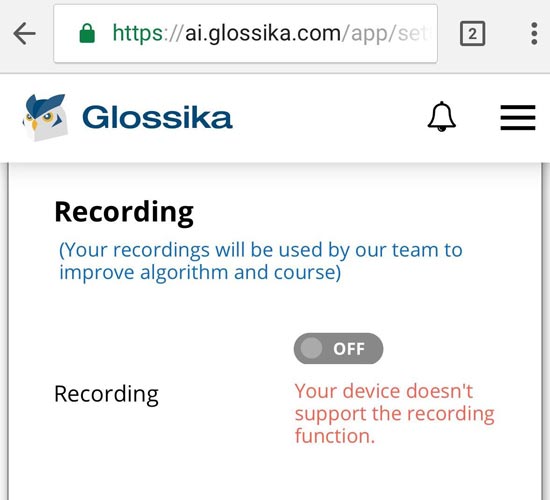
Customer Support
Customer service is integral to any business. Particularly those that sell a service, customers have the right to assistance and should be able to get in touch with the company for any queries or complaints.
Glossika can be reached through their social media channels: Facebook, Twitter, Instagram, and LinkedIn and via email.
I had a fairly pleasant experience with their email support.
Since I was new to the system, I couldn’t understand how a beginner would write in Thai without learning the alphabet. Even though a user could copy the letters that they were being shown, without an understanding of the vowels and the consonants how would they truly learn the words?
I emailed in and asked. Support confirmed that the system isn't for absolute beginners and that they would strongly suggest someone learn the alphabet before starting, or at least be learning it externally at the same time.
I also emailed in to question the simplicity of the system. Because, honestly, the language learning programs I'm used to have lots of different learning tools such as flashcards, video lessons, question-and-answer lessons, word of the day, word lists, useful phrases, quizzes, you name it…
So I was a little baffled and thought I hadn't been given access to all the features. I questioned the repetition vibe as well, which again surprised me because parrot-fashion learning is quite an old concept and one I wasn't expecting.
Glossika confirmed that the system is designed in this specific way and is optimal for language learning.
I did some digging around on what other people thought about this and found some very positive reviews of the program on Reddit, in particular from other language learners who seem to appreciate the system.
As I've said previously, this isn't going to be for everyone. So do try the free trial first.
Glossika Pros
So let's summarise this:
I like the fact that I can adjust the difficulty level of each section anytime I want to: If I want to master speaking simple sentences like a native, I can go on and on. If I feel like I need a more challenging task, I can conveniently choose a higher level.
Glossika uses native-sounding sentences used in everyday conversations, which is ultimately what you want.
The recorded sentences played by the system were of a casual vibe like those used in a daily conversation in Thailand. Colloquially, it was generally on point.
I personally like the writing aspect of it because it challenges me to write Thai, which is an area that I need to work on. It's actually very easy to get speaking Thai without focusing on learning the Thai alphabet and writing, so in this respect Glossika forces you to address that.
I also dig that the membership lets you learn lots of different languages. I am going to test my French later; I haven't spoken any since school.
The daily reminder is cool, too, but actually, in this day and age, it's quite a basic and expected feature.
Areas Of Improvement
Okay, so here's the not so good stuff.
First of all, it’s what I’ve reiterated throughout this review — that Glossika is not for language-learning babies and is meant for those who already have a prior understanding of a language.
This system is not designed for the absolute beginner.
I noticed that the sentences used in all languages available in Glossika are the same. So whether you’re brushing up on your Spanish or Thai, you get the same sentences. While this may hasten your acquisition, it can get a little boring.
This next point is half-positive and half-negative: while I love how the team offers free ebooks and guides to grammar and pronunciation to supplement your learning, this Free Download feature is only available in few languages (Chinese, Japanese, Korean, Italian, Russian, Lithuanian).
Yes, no Thai. The only consolation is that the ebooks contain the IPA and romanized script of sentences in the native alphabet.
I get the whole “It has been developed by language learners for language learners”. In many regards it is no-frills, but executes its simple format and mission very well.
That said, I don't see why they can't advance the platform a tad and introduce an alphabet learning aspect to the system for non-romanized languages. There are of course the guides (mentioned above), but not for every language.
At times I also felt like there could be some additional functionality such as some quizzes or something that mixes up the format a little bit.
But I also appreciate that some people don't want that: some people don't want a lot of distraction, and they just want something very simple; something very straightforward that they know exactly how to jump in on and start using immediately.
Glossika doesn't have all the bells and whistles of other language learning platforms; those that make you click around excitedly looking for new things to discover.
I get why now, because in some respects this can be a distraction to the learning process and encourage you to just jump to the next thing all the time – which isn't conducive to learning.
Indeed, the more I used the platform the more my initial apprehension faded away. I started to understand the strategy more.
My take is that it's an acquired taste that becomes more digestible the more you use it.
I'm sure there are other users out there who have been using it a while and wouldn't want to use anything else. I am also sure there are people that will sign-up and think, no, this is too basic and rote for my liking.
Glossika Pricing
Glossika offers three pricing plans:
- Pro-monthly: priced at $30 a month and gives you access to all features and languages
- Pro-annual: basically the same as the first plan but is billed for a whole year with the discounted monthly rate of $24.99
- Enterprise: built for multiple users (contact them)
Glossika accepts all major debit and credit cards. It also lets you cancel or change plan anytime, so no strings attached. Risk-free.
Conclusion
I guess I went from an initial skepticism of Glossika to an appreciation of what it was trying to do, or indeed what it does do.
It is a streamlined way of learning for those who already have a decent foundation in a language.
If you already have that foundation, you will find Glossika a challenge, and one that almost annoyingly does pull you back in to really test yourself. It has this “beat the system” edge about it that is sort of addictive after a while.
The reason for this is because it very quickly exposes your weaknesses, and if you are really passionate about learning the language you will want to improve on those weaknesses
There are many research studies out there on repetitive learning versus active learning/experimental learning/creative learning/discovery learning, and all the rest.
To be honest, I don't know which one suits me best.
What I do know is that around six years ago I was at a language school and we had a test on the Thai alphabet.
The way I learned that alphabet was by writing it out, and then repeatedly looking at each consonant. After each one, I would close my eyes and draw it in my head.
I carried a notebook around me with one consonant per page; I even took it to the gym.
Within a few days I was ready for the test. When the teacher called out the consonant, I was able to close my eyes, draw it in my mind, and then draw it on the paper.
This is an example of repetitive learning, I guess. Though some people might say that that is visual learning or creative learning, you tell me.
The point is, repetition does work, and will work for most to a degree. Practice makes perfect, so they say. The bigger question is whether there is enough variation here for your personality type.
I think Glossika is a good idea for those who are already actively using a language in day-to-day interactions, and who have limited time available for study.
The simplicity of the user interface and rep system enables you to dip in and out very easily, without having to find where you were within a given module or section of the website.
It's basically an app that is there on the screen in front of you, and within a couple of clicks you are learning, typing, reading, writing, repeating. Simple.
Take the trial and let me know what you think below.
=> Click here to register a free account
Last Updated on

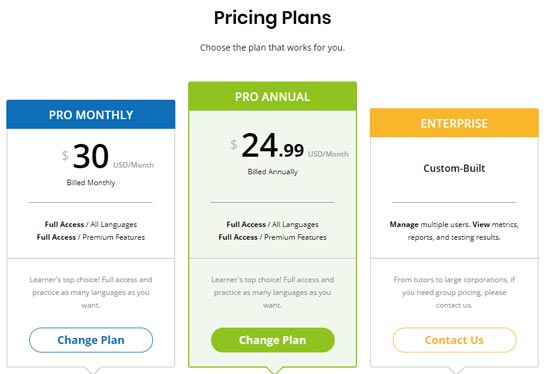

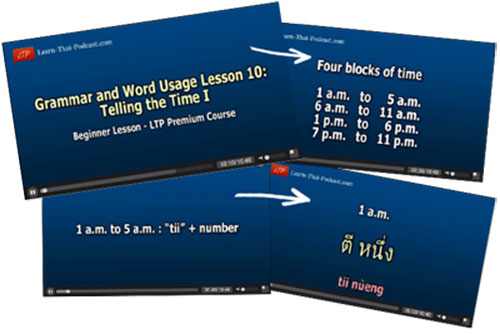
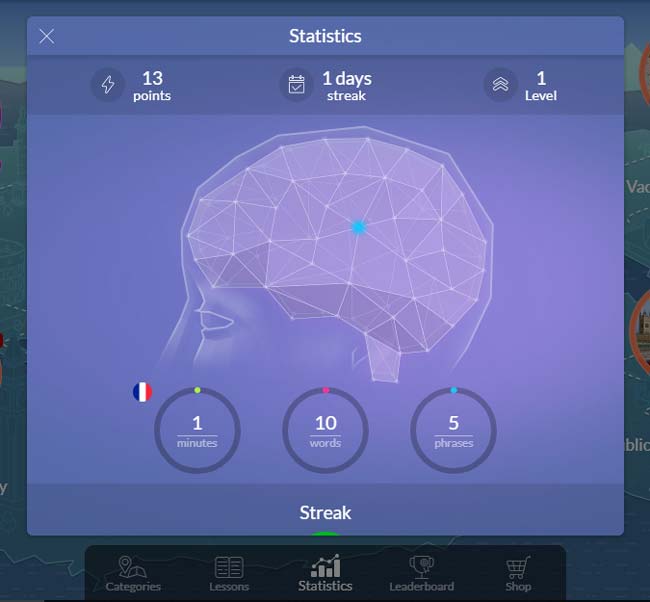
George says
Apr 29, 2021 at 3:38 am
Mr Chris Sables says
As a teaching aid, and not cheap too they should use the same spellings. I have contacted them a few times about this, but they have not acted on it.
Oct 09, 2020 at 8:38 am
RW says
All this depends on your learning style, of course. Yes, it's repetitive, and yes, I also enjoy the addictive nature of trying to beat the system. Currently I am learning around 10-20 new sentences each day, plus reviewing150-200 sentences I've already learned (served up by the algorithm).
And to be clear, I wasn't a complete beginner when I started with Glossika.
I'm not in Thailand, so using Glossika is how I learn and practise the language each day. A friend of mine who's a linguist says that what I'm doing is akin to immersion in the culture. Maybe that is true, at least for the couple of hours a day I'm using the app.
Of course, when I finally get past the current travel restrictions and am once again in Thailand I will face the challenge of speaking with real people rather than the computer, but in the meantime it's fascinating how new and unfamiliar words and phrases are gradually becoming part of what I understand and what I can actually use. Plus I'll be much better at reading signs and menus next time around.
I've always been hopeless at getting the tones right and I've never had formal instruction in recognising/using them, but even that's showing signs of improvement. 37,977 reps (and counting) has to have an impact eventually
It's horses for courses but in its current form, Glossika works for me. I've got heaps of Thai apps, books and other resources, but it's now my main pathway for learning Thai.
Jun 20, 2020 at 2:43 pm
Sj says
2-You had a free month, did you purchase it for more time later?
Feb 24, 2020 at 11:26 pm
TheThailandLife says
Feb 25, 2020 at 6:48 pm
James E says
May 02, 2018 at 10:04 pm
TheThailandLife says
May 02, 2018 at 10:31 pm
James E says
You pointed out that Glossika is (and admits to being) not for new learners. Since starting with the Thai alphabet is not the way anybody learns to speak Thai this puts even beginner/intermediate learners at a disadvantage. Couple that with a course fee of US$300/year(!!!) and there's almost no way to justify Glossika as an accessory to the other options out there. LTP costs either US$20 or $40 (depending on if you catch them during a sale per YEAR. Thaipod101 (at the Premium Level) is less than US$100/year and they include some spaced repetition exercises. If you get their Premium+ access you even get a teacher and still pay less than $200/year.
I'd like to give Glossika a try (I do think it would be a good tool now that I'm learning to read) but at $100 more per year than Thaipod101 PLUS LTP I don't think there's much value there.
May 01, 2018 at 7:35 am
TheThailandLife says
May 02, 2018 at 5:24 pm